Polkadot Weekly|Polkadot becomes the first blockchain ecosystem included in Hong Kong's "Strategic Enterprise Plan"! Parity successfully completes Kusama migration!
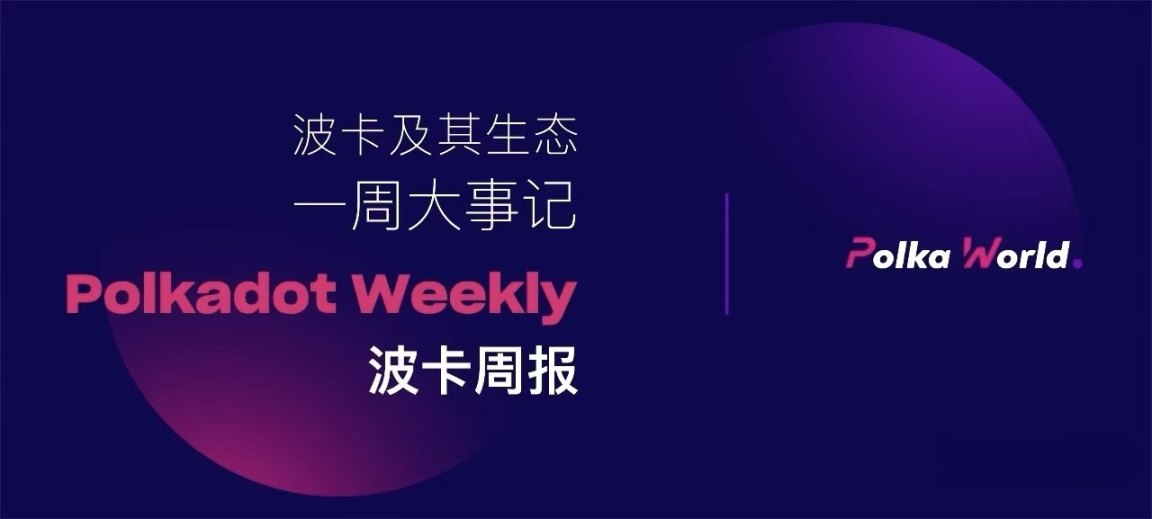
Polkadot
This week, PolkaPort East announced that Polkadot has been officially recognized by the Hong Kong SAR government as a strategic enterprise blockchain ecosystem, making it the first blockchain project in Hong Kong to receive such status.
The signing ceremony was personally presided over by Financial Secretary Paul Chan, with representatives including Ken Kappler from Web3 Foundation, as well as Vincent Chan, Thibault Perréard, and Max Rebol from the PolkaPort East team.
Polkadot has now officially joined OASES (Innovation and Technology Ecosystem Alliance), standing alongside renowned tech companies such as GSK, ARM China, and Xiaohongshu as members. This event has attracted significant attention from both Chinese and international mainstream media, with several outlets, including Xinhua News Agency, extending exclusive interview invitations to Polkadot.
This signing is not only a symbolic milestone but also marks the starting point for Polkadot’s long-term strategy in Hong Kong.

This week, Web3 Foundation released a BEEFY educational article, explaining how cross-chain communication serves as a "digital bridge" in the blockchain era, and why this mechanism enables Polkadot to achieve secure and efficient cross-chain communication with other blockchains, becoming a foundational "connectivity infrastructure" in the digital age.
Web3 Foundation also announced this week that it will officially participate in voting on Polkadot Treasury proposals!
W3F stated that the core objectives of this move are:
- Protect treasury funds: Oppose proposals lacking clear objectives, milestones, or value demonstration.
- Strengthen governance trust: Use consistent and transparent standards to make the community more aware of voting rationales.
- Maintain long-term discipline: Oppose short-term or speculative proposals, prioritizing projects with long-term value for the ecosystem.
The foundation’s voting principles include:
- Focus on strategic and high-impact proposals;
- Avoid projects with conflicts of interest;
- Do not support anonymous or unverified teams;
- Usually vote after community discussion and consensus;
- Each vote comes with a public explanation and is subject to community oversight.
In addition, W3F will continue to advance the Decentralized Voices (DV) program, and will soon increase the voting weight of each DV DAO from 2 million DOT to 3 million DOT. This move aims to give experienced representatives greater decision-making space in the increasingly busy OpenGov environment, while continuing to ensure broad community participation!
Web3 Foundation also updated its Grants funding guidelines this week, clarifying key areas of support!
Key project types of focus include:
- User-centric innovative applications that truly improve user experience;
- Projects that strengthen the $DOT economic model and drive real usage demand;
- Tool-type projects that can be used internally by the ecosystem;
- Teams with financial self-sufficiency plans and the ability to operate independently within 12–24 months;
- Projects that value compliance and regulatory responsibility.
W3F is particularly interested in areas such as cross-border payments and stablecoins, AI applications, DePIN/IoT, privacy-protecting identity verification (Proof-of-Personhood), and Web2→Web3 transition applications.
The foundation also emphasized that it will not support projects unrelated to Polkadot’s features or lacking clear sustainability. For more application details, see the W3F Grants page.

Parity successfully completed the Kusama migration this week!
Currently, Kusama has completed an unprecedented system-level migration: from the relay chain to Asset Hub, with the following migrated:
- 25 core pallets (including governance, staking, treasury, etc.)
- 348,210 accounts
- 17,127,445.03 KSM
- 841,219 storage records
- 25,784 nominators, 8.34M KSM staked
- A total of 118MB of data, 6,000+ XCM messages
The estimated time was 6 hours, but it actually took 3 hours and 13 minutes! Learn more from the data report:

Next step: Polkadot migration will take place on November 4!
Additionally, please be alert to recent fake account scams! Kusama Asset Hub has completed its migration, and users do not need to perform any manual operations to retrieve funds. Recently, there have been fake "Polkadot administrator" accounts posting tutorials or links on "retrieving Kusama funds." Please note these are all fake and unrelated to the official team! Do not click suspicious links or provide your mnemonic or private key to anyone.
Data platform Chainspect released the latest statistics, showing that in the past week, Polkadot remains among the top globally in developer activity, demonstrating strong technical innovation and ecosystem depth.
View the full real-time leaderboard:
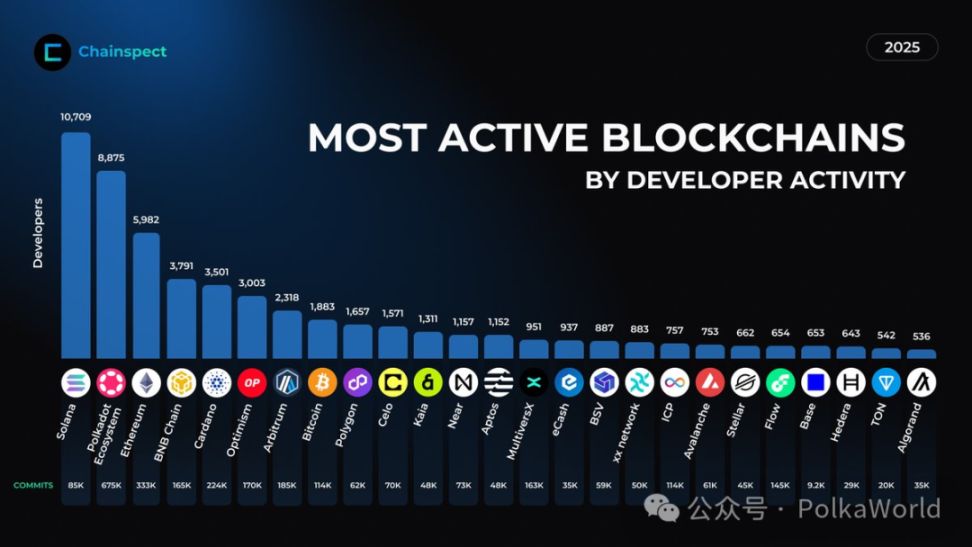
This week, PolkaWorld shared 10 things you need to know about Polkadot’s native stablecoin, pUSD!
1. First, from a global perspective, understand its significance — as the hard cap plan is gradually implemented, there will come a day when Polkadot can no longer maintain its incentive system by "minting more DOT." Therefore, Gavin’s proposed solution is — to have all network rewards and treasury expenditures settled in the stablecoin pUSD.
2. pUSD is a system-native stablecoin issued only by collateralizing DOT.
3. It is issued by the Polkadot network itself, not by Acala/Parity, and is fully managed by the Polkadot Fellowship.
4. It operates as a system-level pallet module (not an EVM contract) on Asset Hub, and is deeply integrated into the Treasury, Staking, and DeFi modules.
5. pUSD’s stabilization mechanism is through over-collateralization + a special pegging mechanism (no stability fee, as both minters and borrowers are the treasury itself) + a new decentralized oracle system.
6. pUSD is minted on demand, and does not require maintaining stablecoin reserves like USDT or USDC currently held in the treasury.
7. pUSD will become the base currency for Polkadot DeFi and treasury incentives, replacing DOT inflation rewards, and will be used to pay validators, Treasury payments, ecosystem incentives, DeFi circulation, and will shift staking rewards from DOT to pUSD earnings.
8. The current network operation is: mint more DOT → pay rewards → dilute all holders.
In the future, Polkadot will become: collateralize DOT → generate pUSD → use pUSD to pay rewards, expenses, and participate in ecosystem DeFi farming for rewards.
9. The goal for the first operational version (initial version): November 2025, possibly running on the testnet (Westend) first; audit and stress testing to be completed.
10. Unlike traditional stablecoins, pUSD is not a freely issued market asset, but rather the economic "lifeblood" at the Polkadot network layer, serving as the central link between treasury, staking, and liquidity.
Learn more in PolkaWorld’s latest article "Polkadot Native Stablecoin pUSD May Launch Test Version in November! Deep Integration with Staking, Treasury, and Ecosystem Incentive Systems!"
This week, Polkadot’s official developer event sub0 announced: in addition to the developer conference, there will also be a 72-hour, overnight hackathon, with a prize pool of $31,000 (still increasing), open to developers and innovative projects from all fields.
This hackathon is jointly supported by @Polkadot, @Kusamanetwork, @Hyperbridge, @web3mktghack, and other teams. On-site, there will be mentor teams providing guidance to help participants quickly refine and implement their ideas.
📍 Location: Buenos Aires, Argentina
📅 Date: November 14–16, 2025
72 hours of non-stop creativity and coding, lighting up the night.
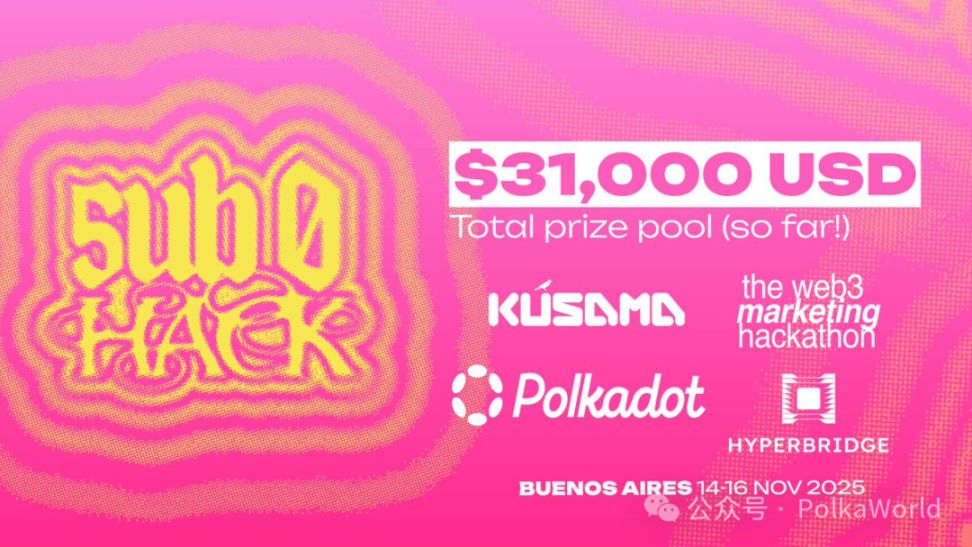
Velocity Labs announced a two-week extension for DeFi Builders Program applications!
Led by Velocity Labs, the DeFi Builders Program has received enthusiastic responses since its launch, attracting many high-quality teams from around the world to apply. To give more outstanding teams the opportunity to apply, the team announced an extension of the application deadline by two weeks — this is also the last chance to join the first batch of project incubation programs!
The program aims to support the next generation of DeFi protocol builders in the Polkadot ecosystem, providing technical guidance, product support, and ecosystem resources to help teams quickly move from concept to viable product.
Application link and details:

Polkadot Builder Party global developer event officially launched!
Hosted by Web3 Foundation and supported by Parity Technologies and multiple ecosystem teams, the Polkadot Builder Party officially kicked off on October 6. This is a six-week global developer festival, combining online hackathons, offline gatherings, and community social activities, aiming to attract a new generation of developers to build open and useful Web3 applications on Polkadot.
The event includes:
🌐 Global hackathon (total prize pool $40,000)
🤝 Community meetups and team collaboration worldwide
📣 #PolkadotParty social campaign
Timeline:
🗓️ Submission deadline: November 17
🗳️ Voting and review: November 18 – December 1
🏆 Results announcement: December 8 (concurrent with Sub0)
This "bottom-up" ecosystem initiative is becoming a landmark event for Polkadot 2.0 to showcase its technical strength and community collaboration spirit. Whether you are a developer, community organizer, or ecosystem contributor, you can be part of the Builder Party.
Parity also held a series of livestreams this week for the Polkadot Builder Party, sharing tools to help developers. See more here:

Additionally, for developers participating in the hackathon, if you want to build a Dapp on Polkadot, you can try the Luno wallet tool. It helps you handle all wallet connections, account management, and network synchronization, and even provides a plug-and-play front-end UI. Basically, one tool solves all Polkadot wallet needs.
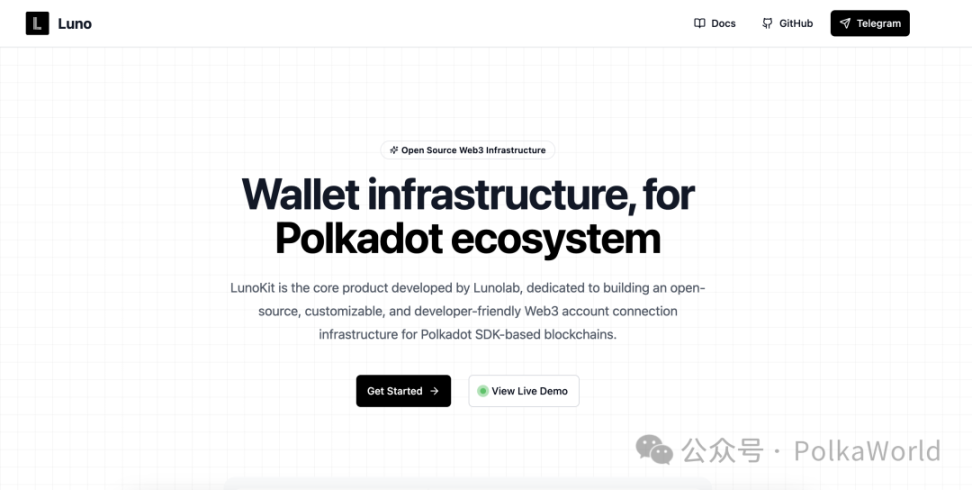
Integration can be done in about 10 minutes. Suppose you want to build a Polkadot decentralized voting dApp for this hackathon, where the front end needs users to connect wallets, read account addresses, send transactions, etc. The process with LunoKit might be:
1. Install packages: npm i @luno-kit/react @luno-kit/ui @tanstack/react-query
2. Set configuration: specify supported chains (e.g., polkadot, kusama), specify supported wallet connectors (e.g., polkadotjsConnector(), subwalletConnector())
3. Wrap your app: wrap the root component with <LunoKitProvider config={...}>
4. Use components like <ConnectButton /> in the UI to let users connect wallets
5. In business logic, use LunoKit’s hooks/APIs to get the current account, signer, and perform on-chain operations
6. Use LunoKit’s state management, caching, and subscription mechanisms to synchronize account changes, network changes, wallet disconnect/reconnect scenarios
This way, you don’t have to develop and maintain a lot of underlying code for these basic capabilities, allowing you to validate, iterate, and launch your product faster.
Try it here:
On October 13, Polkadot Blockchain Academy will join hands with Hong Kong Cyberport to bring a themed event: "How to Bring Your Full Nation On-Chain?" — exploring how to bring "national-level applications" on-chain!
- In-depth analysis of real-world Web3 application cases
- Explore how education × policy × technology jointly promote Web3 adoption
- Hear about the practical achievements of Polkadot Blockchain Academy
- Engage closely with developers, students, investors, and policymakers
This event is also supported by Harbour Industrial Capital and PolkaPort East!
📍 Location: Hong Kong Cyberport
🗓️ Date: October 13 (Monday), starting at 1 PM
Friends in Hong Kong or Shenzhen can register directly:
Learn more about the event in PolkaWorld’s latest article "PBA & Hong Kong Cyberport Co-host Polkadot Offline Event! See You in Hong Kong on October 13!"
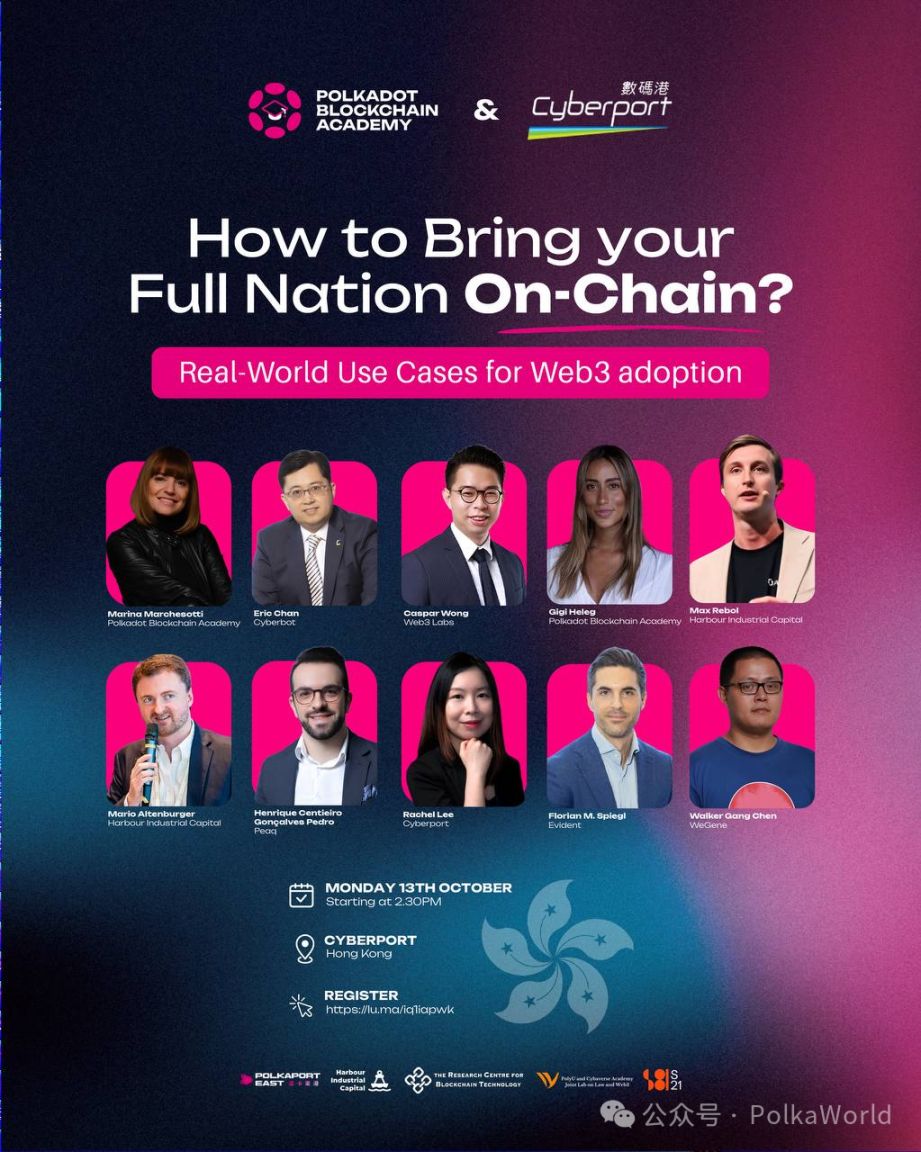
Ecosystem Projects
Bifrost announced that its maintenance mode on the Kusama network has ended, the Asset Hub migration has been officially completed, and front-end services have been fully restored. Bifrost’s DApp is now back online and operating normally.
Everyone can now access staking, liquidity mining, and other functions again.

Chaotic has launched a personalized NFT card series based on Polkadot — Chaotic Cards. Users can generate exclusive NFT cards from their X (Twitter) accounts and mint them for collection on Polkadot’s Asset Hub.
This means that each user’s "digital persona" can permanently exist and be traded as an on-chain asset. The First Edition is now available. This project showcases Polkadot’s new attempt in on-chain identity and creator economy, forming a verifiable connection between social data, personal branding, and NFT collection. Generate your card here!
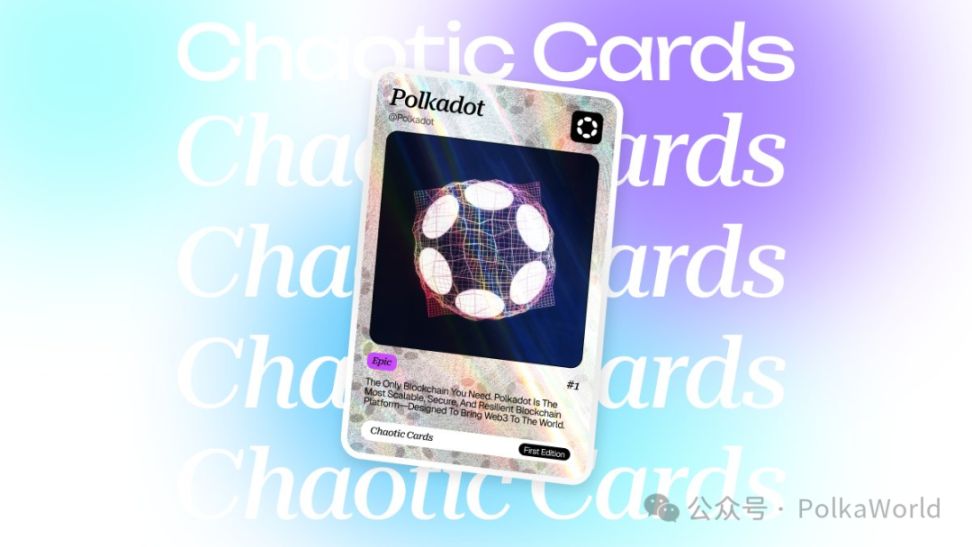
The DeFi Singularity Campaign, driven by Hyperbridge and Bifrost, has been running for over a month, with a total of 795,000 $DOT from treasury funds used to provide liquidity incentives on major networks such as Arbitrum, Base, BNB Chain, and Ethereum.
All operations are executed through Hyperbridge’s cross-chain proof system (proofs). Current progress:
- DOT/ETH, DOT/BNB, and other trading pairs have annualized yields (APR) exceeding 50–80%,
- Total value locked (TVL) has surpassed $3 million,
- User earnings continue to grow, and liquidity is freely flowing across different chains.
Hyperbridge stated that this initiative aims to solve the long-standing "liquidity gap" in the Polkadot ecosystem — in the past, DOT assets were difficult to acquire and use in a multi-chain environment, limiting capital inflow and ecosystem adoption.
Through this campaign, DOT has officially become a cross-chain usable asset and is gradually evolving into a multi-chain reserve asset. Users can view real-time earnings and participate in liquidity mining via the Merkl platform.

Disclaimer: The content of this article solely reflects the author's opinion and does not represent the platform in any capacity. This article is not intended to serve as a reference for making investment decisions.
You may also like
Monad Ecosystem Guide: Everything You Can Do After Mainnet Launch
Enter the Monad Arena.
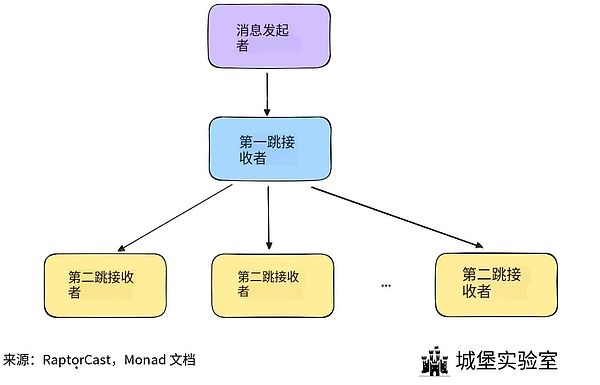
Comprehensive Data Analysis: BTC Falls Below the Critical $100,000 Level—Is the Bull Market Really Over?
Even if bitcoin is indeed in a bear market right now, this bear market may not last long.

Options exchange Cboe enters the prediction market, focusing on financial and economic events
Options market leader Cboe has announced its entry into the prediction market. Rather than following the sports trend, it is firmly committed to a financially stable path and plans to launch its own products linked to financial outcomes and economic events.
Grayscale formalizes its IPO filing

